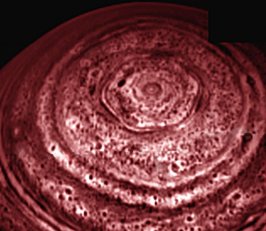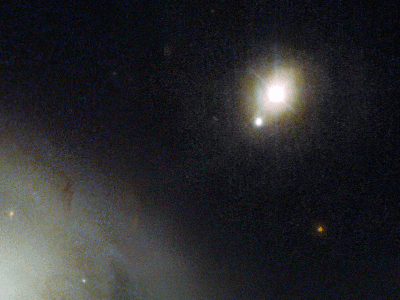I wouldn't say it was an "undeniable physical connection", not by any stretch of the imagination...
With reference to the above image and the alleged 'bridge', is it part of both objects, or just one of them, or indeed neither? It is impossible to say from the pictures alone. If it is a jet coming from (a distant) Mrk 205, surely NGC 4319 could simply be obscuring the rest of it from view? If it is an arm coming from NGC 4319, is there any evidence that it is actually touching Mrk 205, or does it just appear to? What about the other (admittedly smaller) branches from NGC 4319 that lead nowhere? From the pictures, we can't say which way it is pointing, is it towards us, or away from us? It is impossible to say - but the assumption is that it is pointing in the exact direction of Mrk 205
in three dimensions... that's one dimension more than the picture can possibly tell us. The bridge is so faint that it is barely visible before it reaches the point in the image where Mrk205 is, let alone beyond it - but does it disappear because Mrk 205 and it's companion are so bright thus rendering the bridge no longer visible
infront of it, or does is it disappearing
behind it? What is there to say that it actually "connects"?, and not one of these two (incredibly more likely in 3 dimensions) possibilities? And if there really is a bridge (which I think is very far from established) physically connecting the two objects, is it not possible that it is a giant filament of cosmological length? An incredibly rare and unusual object maybe?? Would a high-resolution map of the "bridge" reveal an incremental change in red-shift in the bridge itself??
The problem here is "visual literalism". Does Mrk 205
really have those giant spokes coming from it? No. Is the presence of a companion near Mrk 205 (but crucially facing NGC 4319) significant? Could
it be the reason for the apparent bridge? Probably... (you can even recreate this effect in Photoshop using Lens Flare if you want). In visualising the bridge more clearly by using Photoshop (i.e. bringing the bridge above the noise artificially), does that mean that Mrk 205's halo is pentagonal? Is that real, or an artefact of the processing? Almost certainly the latter, I reckon.
Despite all the above possibilities - none of which I think are unfair or unrealistic, from the available images anyway - the assumptions seem to be that a) the apparent connection is real, and b) that the two objects are relatively close and therefore the apparent connecting bridge is relatively short. Neither claim is any more supported than those above... Unfortunately, these somewhat bold assumptions come at a tremendous cost - a complete abandonment of the vast body of evidence that suggests that the two objects really are incredibly distant (i.e. the standard cosmological interpretation of redshift), not to mention the spectroscopic evidence that places Mrk205 squarely behind NGC 4319 - a simple fact that one simply cannot verify from a mere visual inspection of the images in question.
-
Thanks for the kind offer of a copy of Arp's book - I'm not likely to buy it myself, but I won't stop you sending me a copy if you really want

That said, given the power of the internet, and my privileged access to most of the relevant scientific journals via my work, it may be surplus to requirements.
---
Update, 26.02
According to what I have read in Arp, the sheer statistical association between quasars and galaxies is well beyond chance.
But this does not preclude the possibility that there is some other explanation for the observed "excess" other than that suggested by Arp (that quasars are intrinsically high-redshift objects ejected from low-shift parent galaxies and that they are physically close to each other). Gravitational lensing and cosmic magnification offers another explanation why distant bright point sources such as quasars are more likely found in the same line of sight as massive foreground objects (galactic nuclei, sueprmassive black holes).
The gravitational lensing idea seems unlikely to me, particularly in the famous case of the Einstein Cross, where 4 quasars closely surround one galaxy, while any lensing effect should produce only 2.
It is a pretty big assumption to make that "any" type of gravitational lensing effects should be exactly the same, and/or should behave in exactly the same way/produce the same results. There is already ample evidence to show that this is simply not the case. Modelling has shown that lenses can produce a wide variety of different results - pairs, quads, symmetrical, non-symmetrical etc. etc.
There is also the small matter of time delay measurements in gravitationally lensed images - that is, two or more separate images that exhibit the same variations but at different times. Here's an example of light curves from a very similar object to Einstein's Cross, the quadruply-imaged gravitationally lensed quasar
WFI J2033-4723, to illustrate what I mean...
This is
exceptionally strong evidence that the separate images are not different objects at all, but are infact multiple images of the same object, in this case an intrinsically variable quasar. At the very least, these observations destroy the idea that multiple quasar images must be different objects, and that gravitational lensing is more than capable of generating objects such as Einstein's Cross.





 I didn't realize.
I didn't realize.

 That said, given the power of the internet, and my privileged access to most of the relevant scientific journals via my work, it may be surplus to requirements.
That said, given the power of the internet, and my privileged access to most of the relevant scientific journals via my work, it may be surplus to requirements.